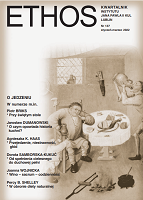KULISY MAGNACKIEGO SPLENDORU OFI CYNY KUCHENNE WARSZAWSKICH REZYDENCJI W CZASACH AUGUSTA III SASA
THE INSIDE STORY OF ARISTOCRATIC SPLENDOR: KITCHEN OUTBUILDINGS AT WARSAW RESIDENCES IN THE TIME OF AUGUSTUS III
Author(s): Alina BarczykSubject(s): Cultural history, Architecture, Social history, Culture and social structure , 18th Century
Published by: Katolicki Uniwersytet Lubelski Jana Pawła II - Instytut Jana Pawła II, Wydział Filozofii
Keywords: Warsaw; the Saxon rule; Augustus III; Heinrich Brühl; Leszno (jurydyka);
Summary/Abstract: Kitchen outbuildings were integral parts of the functional arrangements adopted at residences of the nobility. Although such outbuildings were relatively modest in terms of architecture and décor and, as such, often considered marginal by art historians, ample sources, such as handwritten inventories, correspondence, and cartographic materials, combined with in situ observations, make it possible to provide reliable descriptions of spaces intended for preparing meals and storing food. The present article discusses kitchens, bakeries, and pantries in the palaces of the Warsaw elites in the reign of Augustus III. The author analyzed, among others, the households of, respectively, the Potocki family (in Rymarska street) and the Mniszch family (in Miodowa street), the Lubomirski family (in Żelazna Brama square), and Heinrich Brühl’s house (in Wierzbowa street, in the vicinity of the Saxon Palace). The arrangement of the outbuildings was adapted to the topography of the terrain, one of the marked tendencies being to surround ceremonial courtyards with outbuildings. However, in the case of jurydyka, the functional arrangement might include premises located outside the main residence (as, e.g., in a brewery in Leszno). The inventories provide also details about the movables, such as pastry molds, porcelain dishes or richly decorated glass cups, used to prepare and serve meals. It is emphasized that the role of kitchens becomes apparent only if considered in a wider context of the rule of the Wettin dynasty and the Festkultur of the time, characterized by the special importance and character of feasts, the fashion for lavishly decorated food, and the ceremonial functions of magnates’ residences.
Journal: Ethos. Kwartalnik Instytutu Jana Pawła II KUL
- Issue Year: 35/2022
- Issue No: 1
- Page Range: 81-102
- Page Count: 26
- Language: Polish
- Content File-PDF

